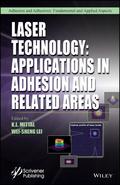Laser Technology
Applications in Adhesion and Related Areas
Adhesion and Adhesives - Fundamental and Applied Aspects

1. Auflage April 2019
448 Seiten, Hardcover
Wiley & Sons Ltd
The acronym Laser is derived from Light Amplification by Stimulated Emission of Radiation. With the advent of the ruby laser in 1960, there has been tremendous research activity in developing novel, more versatile and more efficient laser sources or devices, as lasers applications are ubiquitous. Today, lasers are used in many areas of human endeavor and are routinely employed in a host of diverse fields: various branches of engineering, microelectronics, biomedical, medicine, dentistry, surgery, surface modification, to name just a few.
In this book (containing 10 chapters) we have focused on application of lasers in adhesion and related areas. The topics covered include:
* Topographical modification of polymers and metals by laser ablation to create superhydrophobic surfaces.
* Non-ablative laser surface modification.
* Laser surface modification to enhance adhesion.
* Laser surface engineering of materials to modulate their wetting behavior.
* Laser surface modification in dentistry.
* Laser polymer welding.
* Laser based adhesion testing technique to measure thin film-substrate interface toughness.
* Laser surface removal of hard thin ceramic coatings.
* Laser removal of particles from surfaces.
* Laser induced thin film debonding for micro-device fabrication applications.
Wei-Sheng Lei is a senior technologist at Applied Materials, Inc. on developing advanced technologies and high-value, high-volume manufacturing equipment solutions for laser precision materials engineering applications. He holds a PhD in materials science from Harbin Institute of Technology of China and a Dr. rer. nat. degree in solid mechanics from RWTH Aachen University of Germany. Dr. Lei is the co-inventor of over 100 patents in the US and other countries, and has published more than 100 papers in peer-reviewed journals and conferences.


